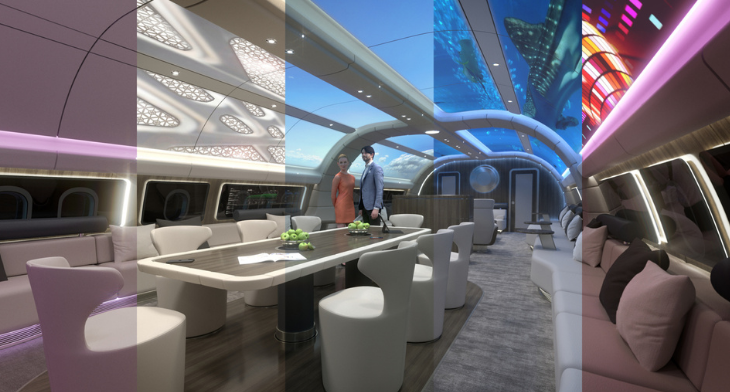Crystal Cabin Awards 2022: Focus on sustainability, digitalisation, flexibility

The Crystal Cabin Awards 2022 competition is returning on 14 June as an in-person event and will see an international expert jury gathering at the Aircraft Interiors Expo in Hamburg.
This year, the main focus is not just about quality, with the shortlist demonstrating that manufacturers, academia and individuals around the world are continually innovating to reduce the environmental impact of aviation and offer new solutions to give airlines more flexibility in configuring their aircraft cabin.
The Crystal Cabin Award is presented in eight categories that include cabin concepts, cabin systems, health & safety, IFEC & digital services, material & components, passenger comfort, sustainable cabin and university. For each category, 28 expert members of the jury select three finalists which will be announced at the beginning of May and the winners will be announced at a gala dinner in Hamburg on the evening of 14 June.
Entries this year include tangible concepts of cabin space re-configurations such as Elevate, an entry by Teague and NORDAM, who have collaborated on a “floating furniture” strategy designed to bring wide-body comfort to the single-aisle business class.
Collins Aerospace, PriestmanGoode and Tangerine joined forces to produce Finnair’s new business class offering, AirLounge. This disruptive design does away with some traditions such as seat recline while embracing others to offer an organic, cocoon-like feel.
The entry shortlist also sees multiple features that take a clean-sheet approach to cabin accommodation such as foldable, reconfigurable elements that allow airlines and passengers alike to reconfigure their expectations of how aircraft cabins use the available space. One example of this is the the ‘Shift Cabin Interior Study’ entry by student Jiayi Yu from the University of Reutlingen. The study allows seats to be configured in multiple positions for work or relaxation along the axis of the seat as well as to the side and fits more seats into the same business class space as existing, fixed seating.
MMILLENNIUMM’s experimental seating concept AirSleeper is an aircraft seat architecture that leverages the available space and passenger ticket price in new ways. Each passenger is provided with a seat that can be folded into a flat bed, accompanied by multiple surfaces both at seat level and above passengers’ heads.
NeXtGC by the German Aerospace Centre gives the “group of six” a surprising new twist. The organisation has created a modular concept that attaches two facing rows of three seats to the sidewall and the floor as well as to a rail system in the ceiling area, freeing up the space usually reserved for overhead bins. Stowage is also provided below the seats for faster passenger in- and egress, while the option to turn the seating into a sleeping area adds a flexible component.
The shortlist also includes several clever ideas to minimise the spread of infectious diseases onboard aircraft. AirShield by Pexco Aerospace in cooperation with Teague uses existing cabin infrastructure to lower the chance of catching an infection by directing a specially designed airflow between passenger spaces, and Weigele Aerospace’s Vientum clean air system takes techniques proven in ground-based systems such as school classrooms into the aircraft cabin to suppress the spread of pathogens like SARS-CoV-2.
Entries that focus on passenger safety include Safran Cabin’s new fire-resistant cargo container that can can inhibit Category D fires for six hours, including those resulting from faulty lithium ion batteries found in digital devices.
Caeli Nova’s Cordillera emergency oxygenation system could, if implemented globally, save 1.2m tonnes of CO₂ emissions annually by allowing aircraft to fly at higher altitudes after a decompression event.
Many entries focus on bringing more sustainability to aircraft interiors. ELeather’s Essence solution recycles leather waste to produce its upholstery and save on raw materials, while Switzerland’s Lantal Textiles in cooperation with Tenerías Omega and Olivenleder has introduced a wet-green tanning process for its leather fabrics using vegetable oils instead of chrome- and gasoline-based chemicals. Aircraft seat cushion maker Metzo’s entry, in cooperation with The Vita Group, features a recycling system for old cushions that offers passengers an option with lower environmental impact.
Waste and weight reduction are also seeing significant development. Airbus Operations’ technology-driven solution is designed to tackle the problem of passenger food waste, with its AI-based Airspace Food Scanner capturing data about passengers’ food consumption that allows airlines to adapt their catering services to better match customer demand.
RECARO Aircraft Seating’s modular, lightweight plug-in seat table system made from sustainable materials promises aircraft weight reduction that according to the company, if adopted for 50 aircraft, could save 1,000 tons of CO₂ annually.
Gentex Corporation’s proposal for an iris biometric scanning system addresses digital and physical security. The company’s engineers envisage an aircraft-wide system, for example authenticating crew when entering the cockpit or implemented in a seatback device to personalise passengers’ media or shopping offerings.
In-cabin digital offerings are also a hotbed of innovation, with KrisShop on KrisWorld embodying a novel approach by Singapore Airlines, airfree and Thales that shows that the future of in-flight shopping will go far beyond paging through a well-thumbed catalogue. Touted as the world’s first in-flight eShopping experience on a seatback IFE system, KrisShop on KrisWorld lets passengers browse a digital catalogue, buy in real-time using a credit card and determining the delivery point, either along their travel route or at home.
AerQ’s engineers have submitted an entry for AERENA, a platform that helps airlines quickly and cheaply adapt onboard apps to personalise their customers’ digital experience while reducing development costs.
Noise cancelling in consumer electronics has seen avid uptake among frequent flyers, and ACM Aircraft Cabin Modification’s MYZONE entry applies active noise cancellation technology to the headrest and beyond. The system is compatible with any aviation seat and its designers say the system can also use window panels and other cabin elements as a loudspeaker, attaining a sizeable 3 dB reduction in aircraft noise.
